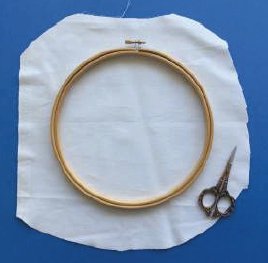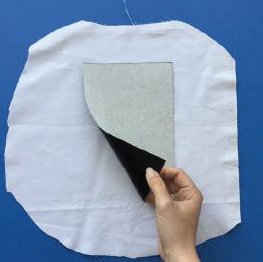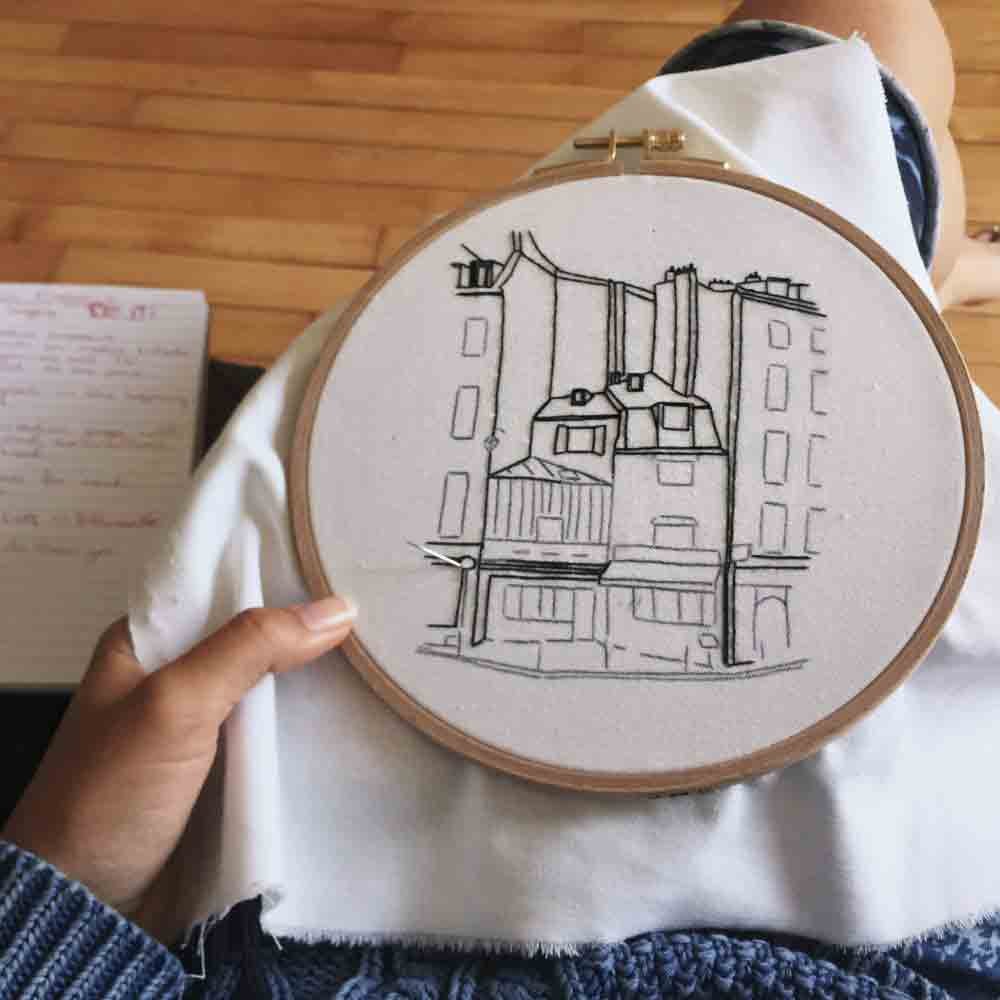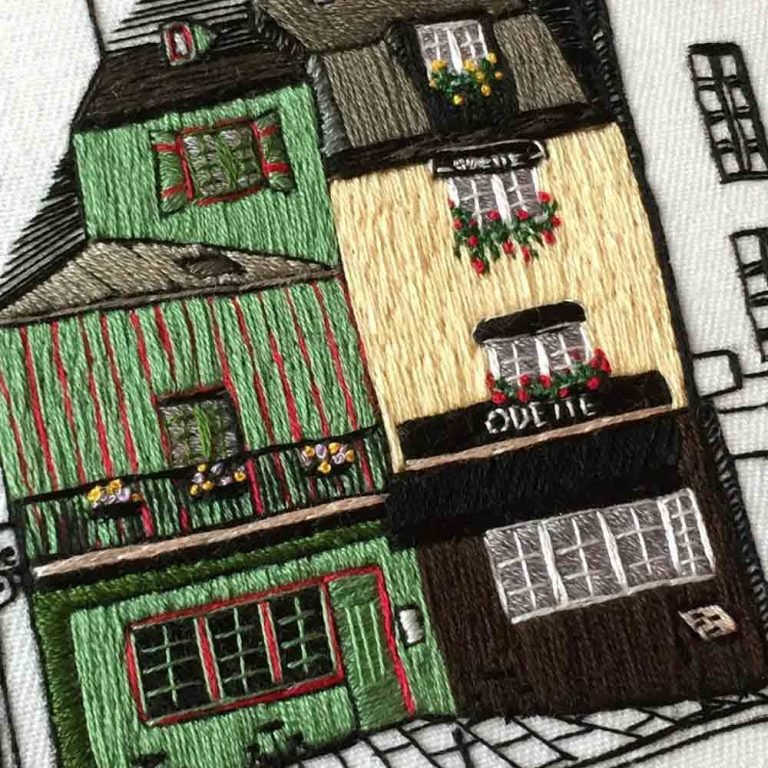Do You Want To Learn Embroidery And Are On The Look For Guides On How To Embroider?
Perhaps you’ve already tried several hand embroidery patterns for beginners and are ready to take on a new style?
If your answer is YES to any of the questions above, then you’re in the RIGHT PLACE. In this article, we will go through how to embroider one of our Architectural embroidery designs.
Unfortunately it’s not that easy to find inspiring free embroidery patterns with instructions, which is why we’ve created that for you!
We believe that to learn embroidery should be fun and accessible. Hence be sure to download your free hand embroidery pattern of Rue Galande by clicking on the image to the right.
This architectural Paris pattern is inspired from Rue Galande in the 5th arrondissement (district).
It’s only a street from Notre Dame at the heart of the City of Love. It’s also one of the streets that we walked down on our first date.
Apart from the obvious romantic associations with the location and design, it’s something about the structures and perspective of this slightly hidden building that is absolutely captivating!
Thus, we had to create an authentic contemporary embroidery design of it!
Upon registration you will receive this Paris pattern as a downloadable pdf
“That looks like an advanced embroidery pattern, I have no idea how to embroider like that?”
If this is you, we just want to say: YOU CAN DO IT.
We fell in love with the modern hand embroidery style for its freedom in expression. In other words, it’s not the amount of different embroidery stitches that makes you a better embroiderer. In fact, we’ve discovered that it’s quite the opposite.
Master a few embroidery techniques very well, and you will be free of limitations for how you combine and use them.This Paris pattern may look advanced, but it’s actually only a handful of embroidery stitches used.
Join our resource center with video stitch tutorials for free! Just click on the image and get started today!
The list of embroidery stitches boils down to the following five:
Backstitch
Satin stitch
Split stitch
Straight stitch
French knot
You can find video-tutorials of all of these five key embroidery stitches on our free video library Going Knots! For you who prefer to read we also have a full article guide here. Thus if you have any hesitation as to how to embroider any of these stitches, be sure to check out the stitch library.
All the embroidery tutorials are done with a close-up perspective and in slow-motion to best serve your needs.
When you become great at a few needlework techniques, you quickly learn how to embroider illusions. This means, to use simple trick and tips to create an illusion of a more advanced and luxurious design.
One such technique is to reduce the number of strands of embroidery thread. For example, you will embroider the contours on this Rue Galande design with only a single stranded black thread.
The contours are stitched with backstitch technique for smooth and neat lines.
The backstitch is sewed exactly the same regardless of the thickness of the thread. However, the result of the stitchery will still be widely different. A thinner thread indicates finesse, whereas thicker threads give a more naive style.
That said… Let’s get into it!
Example of an embroidery design that is stitched with single stranded back stitches. It’s one of our mini embroidery patterns, and the effect of the thin neat lines makes it look impressive and advanced despite it being embroidered with primarily one technique!
But First… Did You Download Your Free Pattern Design Yet?
Before we dig into the instructions for how to embroider this free embroidery pattern download, be sure to get yours! Follow this link and we will send you your pattern as a downloadable pdf.
Now that you have the pattern, you will also need to get hold of the materials needed for this embroidered art work.
Don’t miss to download the Rue Galande design! Click the image and you will receive it as an instantly downloadable pdf.
List of materials you need to stitch your Paris pattern:
Embroidery hoop of 20cm (8″) diameter
Cotton fabric: Kona or Panama cotton (If you take the Kona cotton we recommend to double fold the fabric for more rigidity.)
Carbon Paper (or any other transfer method for “on-top” transfer that you prefer)
Bic pen (only needed if you choose the carbon paper transfer)
Embroidery needle (we prefer thin and long needles such as the 1-5 size)
Sharp scissor
Embroidery floss with codes: DMC745; DMC743; DMC505; DMC554; DMC562; DMC03; DMC646; DMC648; DMC303; DMC310; DMCblanc; DMC816
How To Embroider The Rue Galande Design Step By Step
The first step with every pattern is to transfer the design onto the fabric. Our preferred method is with the carbon paper technique. The reason is that it contributes to the authenticity of the design as you have to redraw it ones by hand. Not only does the process give the drawing a personal touch, but it also allows you to familiarise yourself with the design.
In order to figure out which direction you will stitch, imagine how you would draw the same line with a pen. Thereafter you will be able to easier determine the stitch direction, namely the same direction as you draw. Couldn’t be simpler!
After you’ve successfully transferred the design, you will get started stitching. Begin by embroidering all the contours with the back stitch. To stitch the contours first will give you a better overview of the whole design. Furthermore, it will allow you to see progress slightly faster than if you were to dig into the details and fill out surfaces from the start.
In case you’re new to embroidery it can be very discouraging to start with such a slow medium. Thus begin with the contours and ensure yourself more motivation and enjoyment along the process!
Rue Galande
The FREE pattern of rue Galande, Paris
Enjoy the process and achieve maximum relaxation
We also recommend to sit comfortably and to put on some relaxing music in the background. Perhaps you’d even like to lit a candle or prepare a good drink?
If you turn your embroidery practise into something special, you will feel even greater satisfaction and relaxation purely from the practise. Ones you begin to enjoy the process more than the final result, you can officially declare yourself and embroiderer.
After the backstitch contours completed you can choose whether you wish to continue with the threadpainting areas or keep the graphical look as it is. If you choose to continue to fill out the surfaces, you will do so with a combination of satin stitches and split stitch.
You can see where we recommend which stitch on your pdf pattern. But in short, longer surfaces are stitched with split stitch and shorter (smaller) areas with satin stitch. You can also see on the finished embroidered version where you will shift the direction of your satin and split stitches respectively.
The two aforementioned needlework techniques are the basis for threadpainting. And it’s in this moment that the direction becomes even more important. Instead of changing thread colour to enhance depth, to change the direction creates the illusion of both a differentiation in colours and perspective.
Embroider The Details
When both the contours and the surfaces are ready, it’s time for the most fun part: Details!
For example, the red stripes on the green building to the left immediately makes the building look more advanced. Furthermore, the red nicely complements the green, which makes the colour combination more intriguing.
The same applies to the backstitched red contours around the window frames on the bottom half of the same building. Thanks to the red contours, there is a stronger contrast between the dark window and the green facade.
Another thing to keep in mind is the idea of “what comes first”. For example regarding the windows… Does the glass or the frame come first?
In this case it’s much easier to embroider the glass before you stitch the crossings. Otherwise, you will have to stitch many more shorter stitches to cover each glass square, as opposed to covering the whole window at ones. You can see more what I mean if you compare the windows in the bottom right with the one in the top left.
To the left is another example, where you can see my point a bit clearer. In addition you can also see how a straight stitch on top of the diagonal satin stitches for the glass makes for perfect crossings.
Diagonal stitches
I suddenly mentioned diagonal stitches in the previous paragraph. That’s right. You don’t have to feel limited to horizontal and vertical stitches. Diagonal satin stitches are idea for window glass as it enhances the perception of where the light comes from.
On the Rue Galande design, you can see that the light is imagined to come from the top right, which why the diagonal stitches are following that same direction (top right to bottom left).
To fill out the full window size, you simply vary the length of your stitches so that they fit perfectly into the “box”. That means slightly shorter stitches on the edges and longer in the middle.
The most important for smooth satin stitches is not that all stitches are of equal length. But rather that they’re all aligned parallel to each other.
French knot mini florals
Finally the best part! By reducing the number of strands on your French knots as well, you can create dreamy mini florals for the balconies. We sometimes joke that no architectural design is complete without the idyllic embroidered flowers on the balconies.
Feel free in the placement of the knots. You can also mix the colours that you love and thereby create your own dreamy balcony florals.
French knots or knotted stitch as it’s sometimes called, is probably the most tricky technique that you’ll have to learn. Therefore we highly encourage you to have a look at the video tutorial of the knotted stitch that we have created on our Youtube Channel. It will help you see the process much better than if were to explain it in text.
Can’t wait to see the process on your work! If you choose to share it on Instagram please use the #charlesandelin so that both us and the greater community can see and enjoy it. We’ll gladly share your progress in our stories as well. Embroidery is just so much better when done together!
Did you feel that this article and free embroidery pattern with instructions was helpful? Then be sure to share it with your friends and family as they will probably love it too and you can help each other. Bring your embroideries in progress to your next coffee together and get productive and social in the same time.
Stitching dates are the best!
Relax and feel present with modern hand embroidery
Ps. Did you miss to download your free pattern? Don’t worry we’ve included the direct link for you here again.










